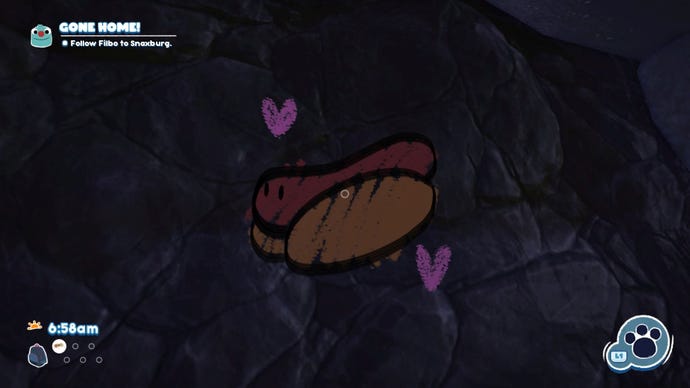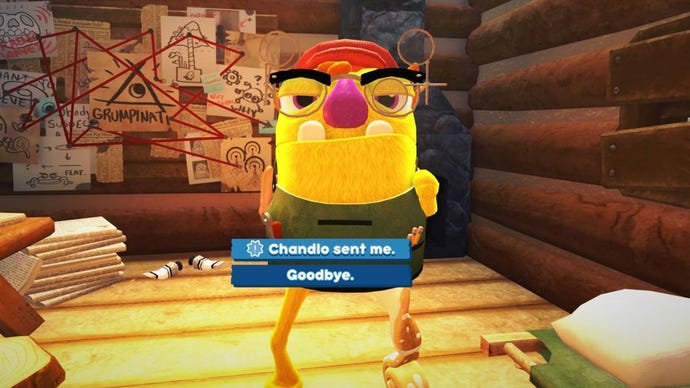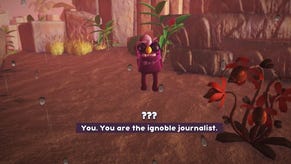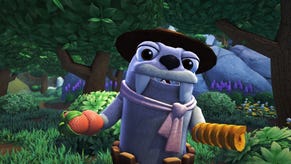How Bugsnax became a source of wholesome queer representation
"Everyone’s normal is different."
At its surface level, Bugsnax is a colourful puzzle game with a great theme song, all about capturing the titular edible creatures. But as I dug into it, I found that it’s also a game about love. The main plot and sidequests all explore each character’s love for someone: a friend, a sibling, a lover, or themselves.
And when Bugsnax explores love, characters of all genders and sexualities get fair treatment. The game gives queer and straight relationships equal weight without explainers or caveats. Its characters respect non-binary people by using the right prounouns without question. In Bugsnax, queer people can just be, which is unfortunately rare in video games.
Bugsnax’s queer representation feels effortless, but I could tell that the creative team put plenty of care into their portrayal of queer and non-binary folks. To learn about the approach the development team took to queer representation, I reached out to creative director Kevin Zuhn and story editor Sage Coffey. Both Zuhn and Coffey told me their experience with queerness impacted their careers, and their creative decisions for Bugsnax.
Coffey’s creative career started with their experiences as a queer teenager in rural North Carolina. They primarily make a living as a cartoonist and illustrator, and their first published comic in The Nib told the story of the discrimination they and their girlfriend faced. “From there, I got the confidence to pitch to more and more places, and started getting regular work! It’s kind of amazing!” they told me.

“A lot of my choices in including and normalising queer identities [in Bugsnax] come from how I want to be seen, and how I already see my friends," Zuhn explained. I want to approach people with different perspectives and experiences with empathy and absurd humour, to combat a lot of cynicism and othering that is commonplace in the media."
Portraying healthy queer relationships was a top priority for Zuhn and Coffey. The Grumpuses, the fuzzy bipedal citizens of Snaktooth Island, face conflicts in their relationships, but Zuhn and Coffey wanted their queer characters to face those challenges in the same way as the straight and cisgender characters.
“It definitely is my ideal that nobody should have to explain or justify their queerness."
“So often queer characters are portrayed as villainous or toxic, and in Bugsnax there is no individual antagonist in that way. Each Grumpus is a fully formed character with their hopes, anxieties, and beliefs," Coffey explained. As such, Coffey feels their conflicts are more character-driven, rather than driven by exterior unacceptance from fellow Grumpuses.
As Zuhn wrote the Bugsnax story, they followed the adage of “nobody is evil, everybody is wrong,” to focus character conflicts on failure instead of malice. “I didn’t really work to ensure that the queer relationships specifically were healthy, it’s just that I wrote the relationship dynamics that I did and didn’t change anything about them based on the characters’ queerness,” they said, of writing healthy queer relationships.
Zuhn and Coffey also made a point of avoiding “explainers” that presented queer people from a primarily cisgender or heterosexual person’s perspective. What’s an explainer? “It’s the scenes where [works of media] sit down with the audience and hold their hand and tell a reader/player/etc. that a character is trans and/or non-binary,” Coffey elaborated. “To me, witnessing that, I understand that this piece of media is made for a cisgender audience.”

They elaborated that in Bugsnax, it isn't explained that Lizbert and Eggabell are lesbians, Chandlo and Snorpy or gay, or that Floofty is non-binary, because it isn't needed. "Everyone’s normal is different. Being gay is normal, being trans is normal, and I think by not including a cis-explainer scene, we’re reinforcing that inclusion in the game. Bugsnax is for everyone, and I don’t want anyone to feel othered while playing.”
“It definitely is my ideal that nobody should have to explain or justify their queerness," said Zuhn. Bugsnax is set a world where that is already true, so anybody in the game pulling you aside to lecture you on different identities would represent a huge break in character. "You’re the Journalist, you live in this world, and you know this stuff already! And hey, if somebody in the audience doesn’t happen to know, I trust them to look it up and learn a bit on their own.”

One of the aspects of Bugsnax’s queer representation that stood out to me was its ability to portray tropes that are common in queer relationships, but not as much in straight romance. There are parts of the story that, for example, touch directly comparing yourself to your partner, or feeling unsure if you’re friends or dating. So, I had to ask: was this on purpose?
Zuhn, who initially came up with these ideas, told me that it kind of just happened. “I’m definitely absorbing a lot from queer relationships all around me, so those specific dynamics felt like the right things to explore. There’s of course a lot of my own past relationships in there, so it’s not like these are feelings I haven’t experienced,” they explained.
“It’s funny because Zuhn didn’t actively decide to include these tropes, but when story editing, it was something I picked up on and commented on immediately!” Coffey added, mentioning that, as a queer person, those moments made them feel “seen.”

The Bugsnax team also built queer inclusion elsewhere in the game’s creation. In this PlayStation Blog post about the game’s voice talents, you can see that the studio listed each character’s pronouns under their name during the ensemble recording. They also found it important to have a non-binary actor, Casey Mongillo, play the non-binary character Floofty Fizzlebean.
“Representation within the production is just as important as representation within the game,” Coffey added. They told me that they were “so happy when [they] saw that [Playstation blog] photo because including someone’s pronouns should be standard! It’s just like including someone’s name on a name tag so you can correctly address them instead of just guessing a random name.”
“In short, asking queer creators to be part of the process is a great way to arrive at inclusive practices.”
For Zuhn, inclusion started with Bugsnax’s writing. “I asked Sage for help editing because, in addition to being a talented storyteller, they have a different perspective from me, and more knowledge of queer culture and negative queer tropes,” Zuhn said, admitting that they walked into some of those negative tropes face-first in early drafts.
“In short, asking queer creators to be part of the process is a great way to arrive at inclusive practices,” Zuhn concluded.
With people across the world playing Bugsnax, Zuhn and Coffey are excited to see their game’s impact on queer representation. According to Coffey, the Brazilian-Portuguese localisation of Bugsnax is the first game in that language to feature gender-neutral pronouns. “When I heard that, I was surprised and to be part of a game that takes such a big step towards queer representation in children’s games is such an honour. I hope queer kids, out and closeted alike, can see themselves in these characters,” they told me.
Zuhn is thrilled to see queer fans’ responses to Bugsnax. “So many people see themselves in these characters and in this world, and they build upon it, way more than we could ever do ourselves. It’s clear that the game is resonating within the queer community, and that fills me with joy!”








